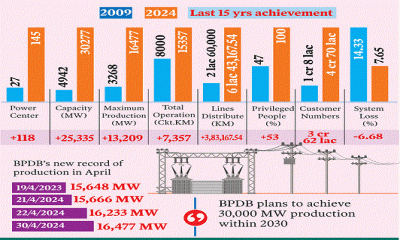# Judiciary's backlog soared to 43 lakh cases by December
# Supreme Court grapples with 6 lakh pending cases
# Average 2300 pending cases per judges, report said
With the pending cases, the country's judiciary system is in troble that creates burden on judges. A recent statistics revealed that a staggering average of over 2,300 pending cases per judge.
Legal experts attribute the litigation crisis to a shortage of judges and court resources, compounded by challenges such as legal defects and difficulties in producing witnesses. Lawyers emphasize the urgent need to address these issues to alleviate the burden on litigants and expedite the trial process.
Until last December, Mymensingh Land Survey Tribunal court alone accounted for more than 37,000 pending cases, echoing a similar scenario in Sherpur and Jessore Land Survey Tribunals, where two judges are tasked with handling 18,000 and 12,000 cases respectively. This overload extends nationwide, with judges in all courts facing four to five times more cases than their capacity allows.
The judiciary's backlog has soared to 43 lakh cases by December, with subordinate courts bearing the brunt at 37 lakh 30 thousand cases, while the Supreme Court grapples with approximately 6 lakh pending cases. This marks a doubling of the backlog since 2012, raising concerns about the effectiveness of the legal system.
In 2008, there were seven judges in the Appellate Division. There were 6 thousand 892 pending cases. After that, the number of judges in the Appellate Division never fell below seven. At present there are eight judges in the Appellate Division. And till last December there were 26 thousand 517 pending cases.
Similarly, there were 2 lakh 93 thousand 901 pending cases in the High Court Division of the Supreme Court in 2008. At that time there were 67 judges in the High Court. After 2010, the number of judges in this department never fell below 90. But the caseload is on the rise. At present, 84 judges are serving in the High Court Division. And the number of pending cases in this department is 5 lakh 43 thousand 847.
At the time of the separation of the judiciary in November 2007, there were 301 judges in the subordinate courts. On the contrary, the pending cases were about 13 lakh. At present, out of more than 2,000 judges, about 1,800 are working at the field level, and 37 lakh 29 thousand 235 pending cases in subordinate courts.
Chief Justice Obaidul Hasan said in a recent event, “There are not enough judges in Bangladesh that need to be there. A judge for 90 to 95 thousand people in the country. It is not possible to reduce the backlog of cases with so few judges. This number should be increased. Logistics support and other facilities should be increased.”
Additional District and Sessions Judge of Kushtia, Muhammad Tajul Islam said, “Mainly, the entanglement of cases increases due to two reasons. One is the infrastructural problem and the other is the legal complexity. Ajalas and judge crisis is one of the infrastructural problems.”
He also added that to reduce the confusion, minor problems should be solved outside the court. Criminal law also calls for increasing the use of alternative dispute resolution or ADR procedures. At the same time, investigation time should be reduced, judges and those concerned should be properly trained. Apart from this, if a new thana or upazila is created, the post of a judge should be created for the thana or upazila associated with UNO, AC land.
Meanwhile, The Law Commission submitted a report in August last year recommending speedy disposal of cases and reducing congestion. The report identifies five main causes of confusion in criminal and civil cases. They are: insufficient judges, insufficient appointment of judges in specialized courts, false and harassing cases, lack of manpower and poor infrastructure.
ZH






